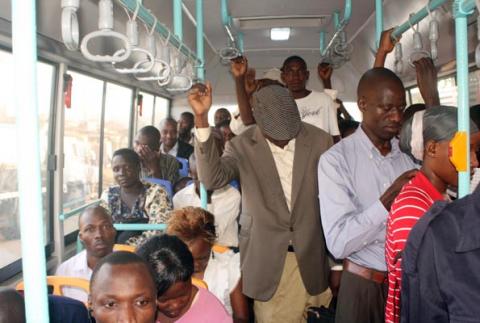A Peek Inside Pioneer Bus at Peak Hour
Submitted by wakaija on

Peak hours between 5pm-8pm give one the reality of what goes on within the walls of a Pioneer bus as it snakes through the congested roads in and around Kampala.
With 30 spacious seats and a large aisle, the interior creates the impression of a comfortable travel experience until he/she actually sits in.
In those aisle there are plastic handles dangling from the roof and thin pillars supporting the rails above near the bus roof. Each thin pillar has a red button and each rail has dangling plastic handles.
Of the thirty chairs, four are yellow specifically set apart for people with disabilities that include the lame, elderly, expectant mothers and those with babies.
The Queue
Henry Kaseehe commutes to and from Kirinya in Bweyogerere daily. A businessman in downtown Kampala, he regularly travels by Pioneer bus in what says is a cost-cutting measure. “I spend much less on transport than I would in a taxi or on a boda boda,” he says.
Kaseehe adds, however, that the near-stampede during peak hours is a major turn-off for him. “It is a fight, especially in the evenings. Some people even exchange blows as they struggle to get onto the bus,” he explains.
On entering, passengers pay up one thousand shillings to the driver who issues a receipt. The first to come are served with the empty seats which give one a feel of victory after a tough battle in the long queue outside to get in. Yellow seats can always be passed by as one is always sure to be displaced by those to whom they belong.
Priscilla Kisakye, a regular traveller on the Pioneer Bus plying the Kampala-Mukono route, says she can never bother to sit on a yellow seat as chances for displacement are always high. “It is as good as standing,” she says.
More and more passengers keep streaming in to fill up the spacious aisle holding onto the dangling handles. This aisle is supposed to accommodates thirty one of the passengers. As more get in, however, it gets to the level of squeezing in till statements like 'Ayimirire wa naawe?' of “Where should he or she stand!” begin emerging from the passengers.
In due time, the once bright Pioneer bus is darkened by the thickness of people within and one can't even notice a neighbour two feet away. Passengers are squeezed, can't move a foot, neither a hand nor a head. One only owns their body size space. This is when passengers begin calling for opening of windows and all ventilation avenues. This is usually at the mercy of those seated. Some object to the demand indifferent to the level of heat those standing are experiencing.
Some passengers have testified to have nearly suffocated while in the bus. Florence Mweere, a resident of Bweyogerere, affirms that whenever she stood, she nearly suffocated and got dizzy and it is for that reason she struggles for a seat so that she does not have to stand.
Besides the heat, the air within the bus is always stuffy at peak hours and one has to keep their nose to the window. Passengers are often heard complaining of a ‘smelling neighbour’ which is because of how packed people inside are. These actually enter the bus from all places: market, offices and some bars among others.
The noise inside a pioneer bus is uncontrollable especially whenever passengers are displeased with the level of packing them up for the ride. Whereas passengers hurl insults and demands at the driver, a regular patient is calling upon sympathizers for financial support and a preacher calling upon people to repent. On a good day, the bus is filled with chuckles and laughter for the muse of jokes from different bus corners.
Arafat Rasuuli, a regular bus user lightly expresses his love for humor within the pioneer bus. "Pioneer bus has a lot of comedy for me. You see people quarrel, argue, joke and this just amuses me," he says.
At certain points along the way the bus is bright, free and light again as more people press the red button that is meant to alert the driver to stop. Those standing dash to fill up each of the seats that are vacated.
Started in 2012, Pioneer Easy Bus Limited is registered as a locally incorporated company to serve the public transport needs within the greater Kampala Metropolitan Area. It charges a fixed cost for all distances. The shorter routes go for 500 Shillings while passengers travelling on longer routes pay one thousand Shillings.
Shortly after it started operations however, the Uganda Revenue Authority impounded 100 of its buses over failure to pay about 8 billion Shillings in tax arrears. It would remain out of operations until 2015 when it resumed. Most of its fleet of buses remain grounded in the parking area at Mandela National Stadium, Namboole.
Photo from The Daily Monitor
- 932 reads
